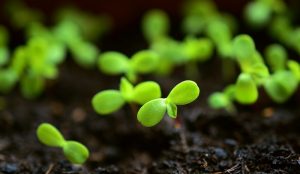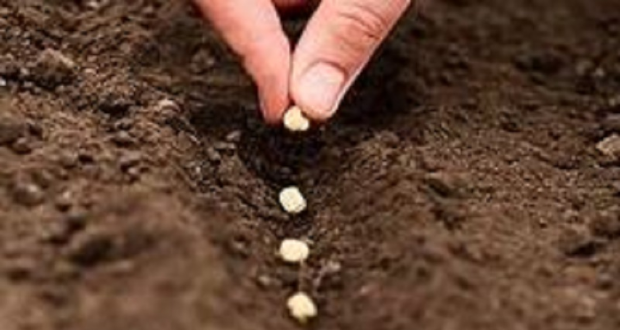By Bob Labozetta (UC Master Gardener, Mariposa)
 Some plants just don’t lend themselves to indoor seeding and later transplanting. They prefer to start and finish in the same place. This is usually due to having a delicate root system. Beans, beets, carrots, corn, cucumbers, lettuce, melons, peas, radish, scallions, spinach, squash, swiss chard, turnips, zucchini prefer direct seeding.
Some plants just don’t lend themselves to indoor seeding and later transplanting. They prefer to start and finish in the same place. This is usually due to having a delicate root system. Beans, beets, carrots, corn, cucumbers, lettuce, melons, peas, radish, scallions, spinach, squash, swiss chard, turnips, zucchini prefer direct seeding.
There are several methods of direct sowing seeds. In raised beds, square foot gardening, or intensive gardening, seeds are planted in grid patterns spaced evenly in all directions. This is known as the block method. In square foot gardening, each square holds specific numbers of plants based on guidelines. Simply drop seeds in holes poked in the soil, cover, and water.
Mound or hill gardening involves raising the soil into a small hill that will drain well and heat up quickly, similar to a raised bed. The warmed soil helps seeds germinate quickly. Planting squash and cucumbers in mounds in the center of the garden bed allow the vines plenty of room to stretch out. Rake the soil into a mound of about 6-inches (15 cm) high and 1 or 2 feet (30-60 cm) in diameter depending on the crop. Level the top and plant your seeds according to the seed package directions for depth and spacing. Keep the soil damp until the seeds sprout.
If you plant in furrows or rows, dig a shallow trench through the soil at the depth indicated on the seed package. Sprinkle your seeds along the length of the trench according to the spacing recommendations on the seed package. Cover the seeds with soil, water gently, and keep the soil moist.
Follow seed packet instructions regarding the best time to sow the seeds, how deep to sow them, how far to space them apart, and how to thin the seedlings once they have sprouted.
Direct sowing requires planting thickly and thinning after the seeds sprout. Save the healthiest and strongest plants and use a pair of scissors to clip unwanted plants at soil level. Don’t pull them out by the roots as it may disturb the root systems of other seedlings.
Use plant stakes to mark your planting location. Gently water the bed and keep the soil uniformly moist (not waterlogged) until the seeds sprout. After the seedlings are established, let the soil dry slightly between watering.
After plants are established and thinned, mulch the beds to retain moisture and inhibit weeds. Keep the mulch several inches from the stems of the seedlings to prevent smothering of the plants.
A combination of both indoor sowings for transplanting later and direct seeding into the garden lead to more successful vegetable gardening.
————————–
UC Master Gardeners of Mariposa County serves Mariposa County, including Coulterville, Greeley Hill and Don Pedro. For gardening and event information, call us at 209-966-7078 or email mgmariposa@ucdavis.edu. Find us online at http://cemariopsa.ucanr.edu/Master_Gardener, on Facebook (UC Master Gardeners of Mariposa County), and on YouTube at “UCCE Mariposa.” Listen to us on KRYZ 98.5 FM radio Wednesdays at 2pm and Saturdays at 5 p.m.




